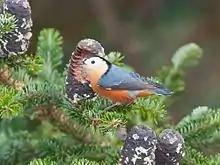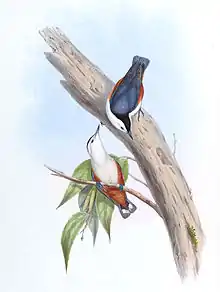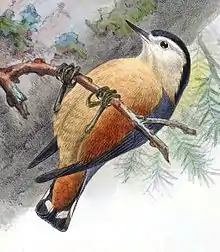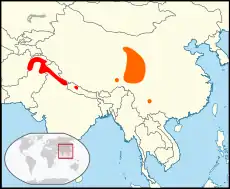Przevalski's nuthatch
Przevalski's nuthatch (Sitta przewalskii), originally given the nomen nudum Sitta eckloni, is a bird species in the family Sittidae, collectively known as nuthatches. Long regarded as a subspecies of the white-cheeked nuthatch (Sitta leucopsis), it nevertheless differs significantly in morphology and vocalizations. Both S. przewalskii and S. leucopsis have been regarded as closely related to the North American white-breasted nuthatch (Sitta carolinensis). It is a medium-sized nuthatch, measuring about 13 cm (5 in) in length. Its upper body is a dark gray-blue or slate color, becoming dark blue-black at the crown. The cheeks and throat are a white buff-orange, turning to a rich cinnamon on the underparts that intensifies in color on the sides of the breast. Vocalizations consist of alternating series of ascending whistles and short notes.
| Przevalski's nuthatch | |
|---|---|
 | |
| In Gansu, China | |
| Scientific classification | |
| Domain: | Eukaryota |
| Kingdom: | Animalia |
| Phylum: | Chordata |
| Clade: | Dinosauria |
| Class: | Aves |
| Order: | Passeriformes |
| Family: | Sittidae |
| Genus: | Sitta |
| Species: | S. przewalskii |
| Binomial name | |
| Sitta przewalskii Berezowski & Bianchi, 1891 | |
The bird is endemic to areas in southeastern Tibet and west central China, including eastern Qinghai, Gansu and Sichuan, inhabiting coniferous montane forest of spruce or fir. The altitude at which it nests varies according to locality, but typically is from 2,250–4,500 m (7,380–14,760 ft). The species was first described in 1891 from a specimen collected in China's Haidong Prefecture. The common name and Latin binomial commemorate the Russian explorer Nikolay Przhevalsky, who first recorded the species in 1884. Little is known about its ecology, which is probably comparable to that of the white-cheeked nuthatch.
It was given the rank of full species (separate from the white-cheeked nuthatch) in 2005 in Pamela C. Rasmussen's Birds of South Asia. The Ripley Guide. Other authorities followed suit, but as of 2014, S. przewalskii does not have a full threat-status evaluation by BirdLife International or the International Union for Conservation of Nature. A 2014 phylogenetic study of the species found it to be at the base of the nuthatch evolutionary tree out of 21 species examined, dispelling a hypothesis that S. przewalskii could belong to the same species as S. carolinensis.
Taxonomy

The nuthatches constitute a genus – Sitta – of small passerine birds in the family Sittidae.[2] The genus may be further divided into seven subgenera,[fn. 1] of which S. przewalskii belongs to Leptositta, along with its nominate subspecies, Sitta leucopsis, and the white-breasted nuthatch (Sitta carolinensis).[3] Nuthatches are typified by short, compressed wings and short, square 12-feathered tails, compact bodies, longish pointed bills, strong toes with long claws, and behaviorally, by their unique head-first manner of descending tree trunks. Most nuthatches have gray or blue upperparts and a black eyestripe.[4][5] (One recognizable feature of Przevalski's nuthatch is that it lacks the eyestripe common to most nuthatch species.[6])
Sitta is derived from the Ancient Greek name for nuthatches, σίττη, sittē.[7][8] "Nuthatch", first recorded in 1350, is derived from "nut" and a word probably related to "hack", since these birds hack at nuts they have wedged into crevices.[9]
Sitta przewalskii was first scientifically described in 1891 by Russians Mikhail Mikhailovich Berezovsky and Valentin Bianchi[10] based on a single specimen obtained in the Haidong Prefecture, in Eastern Qinghai.[11] The common name and Latin binomial commemorate the Russian explorer Nikolay Przhevalsky,[12] who found the species in Tibet in 1884 and dubbed it Sitta eckloni without providing adequate description, rendering it a nomen nudum.[13][14] Though the primary habitats of Sitta przewalskii and the white-cheeked nuthatch (Sitta leucopsis) are separated from each other by almost 1,500 km (930 mi),[15] Przevalski's nuthatch was described as closely related to the white-cheeked nuthatch, and was thereafter often considered and treated conspecifically, as a subspecies of S. leucopsis.[16][fn. 2]
In 2005, Pamela C. Rasmussen granted the taxon autonomous status in her book, Birds of South Asia. The Ripley Guide, uncoupling the species from S. leucopsis.[17] The classification was noted by ornithologists Nigel J. Collar and John D. Pilgrim in 2007,[18] and endorsed by the International Ornithological Congress, by Alan P. Peterson in his well-known Zoological Nomenclature Resource (Zoonomen),[19] and by the Internet Bird Collection (IBC), sponsored by the Handbook of the Birds of the World.[20] No subspecies of S. przewalskii itself have been identified.[21]
In explaining this separation of species, Rasmussen points to morphological divergence and significant differences in vocalization.[17] Ornithologist Edward C. Dickinson observed in a 2006 article that though evidence of morphological and vocal differences between S. przewalskii and S. leucopsis have been delineated, little had yet been published presenting comparative morphological details, and that it would be instructive to study how each taxon responds to the calls of the other.[22]
Nuthatches according to Pasquet, et al. (2014):[5]
- Sitta
- White-breasted nuthatch (S. carolinensis)
- Giant nuthatch (S. magna)
- Other nuthatches
- Przevalski's nuthatch (S. przewalskii)
The white-cheeked nuthatch, with S. przewalskii subsumed within it, has been regarded as closely related to the North American white-breasted nuthatch (Sitta carolinensis), which has a similar contact call (though S. carolinensiss's is moderately higher in pitch), and they have sometimes been treated as conspecific. In turn, it has been proposed that the triumvirate of S. przewalskii, S. leucopsis and S. carolinensis could be related to the Sitta canadensis, monophyletic group, corresponding to the subgenus Micrositta, which includes six species of average-sized nuthatches.[fn. 3] The relationships remain very unclear.[3][23][24] A molecular study by Eric Pasquet conducted in 2014 may provide some clarity.[5]
In 2014, Eric Pasquet, et al. published a phylogeny based on examination of nuclear and mitochondrial DNA of 21 nuthatch species. Though S. leucopsis was not included in the study, it found that within the nuthatch group covered,[fn. 4] S. przewalskii is basal—an ancestor at the base (or root)—to the nuthatch evolutionary family tree, and thus "sister to all other nuthatches, without any close relatives".[5] The findings resulted from phylogenetic analyses (employing Bayesian inference and the maximum likelihood methods). A biogeographical analysis (using the dispersal-extinction–cladogenesis model) was then performed. The cladogram drawn from the evidence indicates that the first clade and closest descendants of Przevalski's nuthatch are the North American white-breasted nuthatch and the giant nuthatch (S. magna), dispelling the hypothesis that S. przewalskii could belong to the same species as S. carolinensis.[5]
Description

Because Sitta przewalskii has long been regarded as a subspecies of the white-cheeked nuthatch, its description has often been made in comparison with it.[16] Though both species lack the black eyestripe typical of other nuthatches, their coloring is distinct, with S. leucopsis being white- or creamy-buff on its throat, cheeks, breast, flanks and belly, where S. przewalskii has varying shades and concentrations of cinnamon. S. przewalskii is also the smaller of the two, and its bill is markedly thinner.[17][25] Males and females of the species are nearly identical in appearance,[26] except for the male's brighter cinnamon coloring.[17]
The area above the eyes, including the forehead, crown and nape, is a deep blue-black, through the top edge of the mantle. The mantle proper is a medium to dark gray-blue as are the tertials and upperwing-coverts, turning to a dark gray at the median, greater and primary coverts and the alula. The secondaries and inner primaries are fringed in gray-blue. The central rectrices are gray-blue, and the outer rectrices are a blackish-gray, paling towards the tips.[4]
The face and surrounding areas, including the lores, supercilium, ear-coverts, cheeks and throat are a white buff-orange.[4][27] Below, the belly and breast are a rich cinnamon, darkening to an orange-cinnamon at the sides of the breast. The rear flanks and undertail-covert feathers are rufous.[4][28] In worn plumage, the color may be uneven in the lower parts and lighter in hue. The upper mandible of the bill is black, and the lower is gray with a black tip. The iris and legs are dark brown.[16] Juveniles of the species resemble adults but for the base of their beaks being yellow, proportionately shorter, and their overall coloring being less vibrant.[4]
Przevalski's nuthatch is a medium-sized bird, measuring about 12.5–13 cm (4.9–5.1 in) in length.[6][16] The folded wing of the male is 72–77 mm (2.8–3.0 in) long and that of the female 69–74 mm (2.7–2.9 in); an average of 4 mm (0.16 in) shorter than the white-cheeked nuthatch. The wingspan is about 22.5 cm (8.9 in). The beak measures 17–17.6 mm (0.67–0.69 in), which is thinner and shorter than that of S. leucopsis, in which the beak is approximately 21 mm (0.83 in) long.[23] The tarsus is 18 mm (0.71 in), and the tail is 43 mm (1.7 in) in length.[16]
Vocalizations and behavior
Sitta przewalskii's territorial calls differ significantly from those of S. leucopsis, whose notes are more nasal, whereas the song of S. przewalskii is in long verses composed of whistles that ascend in pitch, interspersed with short notes.[15] According to the Handbook of the Birds of the World, vocalizations include a "muffled, mellow 'chip' repeated in irregular series...; a loud, emphatic, whistled 'dweep' or 'dweep-eep'; a slightly nasal, querulous 'que', usually repeated 3–5 times...; and thinner 'pee-pee-pee-pee...' or 'seet-seet-seet-seet...' notes on [the] same pitch but slowing towards [the] end of [the] phrase."[4]
In 1950, English naturalist Frank Ludlow reported a description of the bird, as provided to him by Ernst Schäfer who studied an adult male near Litang in 1934. It was characterized as: "one of the shyest and rarest denizens of the conifer forest",[29] and one leading a solitary life, much like nearby populations of three-toed woodpeckers (Picoides tridactylus funebris). By contrast, Ludlow observed the species in southeastern Tibet, probably during the winter, and did not find it particularly reserved. He reports having killed a specimen in a willow tree, far from the species' usual coniferous nesting grounds.[29] The specimen was captured on the outskirts of a forest, on a ridge between two valleys, where it stood on a dead branch from which it launched in pursuit of insects in flight, like a flycatcher.[10][16]
Distribution and habitat

The species is endemic to an area in west central China and southeastern Tibet.[21] In China, it is found in eastern Qinghai, from the Daba Mountains as far north as the Menyuan Hui Autonomous County, and as far south as the plateau of Amdo (35° N. 101° E.), as well as in the southern part of Qinghai in Nangqên County; in the area of the Yellow River in Xinghai County; in Gansu, southwest of Xiahe and Min counties; in Sichuan, where it has been observed in the north, center and west of the province, including sightings in Songpan County at the Jiuzhaigou Valley nature reserve, in the Qionglai Mountains in the Wolong District, in the region of Barkam County, and in the area of Litang. The species has also been observed in Kunming, Yunnan, in far southwestern China, where it most likely migrates to overwinter.[6]
In Tibet, the species has been found in the northeastern Tibet Autonomous Region in the Chamdo Prefecture; and in the southeast of the region in Tse (in December) and in Dzeng (in April), both in the South Tibet (Tsangpo) Valley region. The Tsangpo Valley sightings may be anomalous, only indicating winter visitation. The bird observed in Dzeng was in an environment alien to the species' normal coniferous forest environs, and both the Dzeng and Tse individuals had atypically pale underparts, indicating they may have been nominate S. leucopsis, but with genetic introgression traits from Przevalski's nuthatch.[4]
S. przewalskii inhabits coniferous montane forest of spruce or fir. Its altitudinal range commonly approaches a forest's tree line. In China it has been observed at height distributions of 4,270 m (14,010 ft) (in Sichuan during August) and in Qinghai at 2,590–2,895 m (8,497–9,498 ft) and at approximately 2,250 m (7,380 ft) (during June). In western Nepal a range of 2,745–4,575 m (9,006–15,010 ft) has been described. In Tibet individuals have been recorded at heights of 3,500–4,500 m (11,500–14,800 ft) in the northeast, and from 2,895–3,050 m (9,498–10,007 ft) in the southeast.[29][30]
Threats and protection
Sitta przewalskii is not yet treated as an independent species by BirdLife International or the International Union for Conservation of Nature, and its threat level is not evaluated by either. Despite being described as rare in China and Southeast Tibet,[30] because the taxon is treated instead as a subspecies of S. leucopsis, the evaluation of its population incorporates the relative abundance of its parent species.[fn. 5] Concomitantly, it takes on its parent category of least concern.[1][31] As S. przewalskii has not been extensively studied independently from S. leucopsis, a classification of data deficient could be applied, but the rarity of sightings indicates concern for its status; a finding of near threatened or even classification as a vulnerable species may be warranted.[4][fn. 6]
Notes and references
Notes
- ^ Being Callisitta, Poecilositta, Oenositta, Sitta, Mesositta, Micrositta and Leptositta.[3]
- ^
- ^ Being the red-breasted nuthatch (Sitta canadensis), Chinese nuthatch (Sitta villosa), Yunnan nuthatch (Sitta yunnanensis), Krüper's nuthatch (Sitta krueperi), Algerian nuthatch (Sitta ledanti) and Corsican nuthatch (Sitta whiteheadi).[32]
- ^ The 21 species are out of 24 recognized as making up the genus by Harrap and Quinn as of 1996. Of these, the study omitted the Indian nuthatch (Sitta castanea), the yellow-billed nuthatch (Sitta solangiae) and the white-browed nuthatch (Sitta victoriae). It treated S. przewalskii as a subspecies of S. leucopsis. The International Ornithological Congress however recognized 28 species as of 2012, based on the elevation of four taxa from subspecies to full species status, including Przevalski's nuthatch and three species from the europaea group.[5]
- ^ According to BirdLife International, the population of S. leucopsis as a whole (i.e., including Przevalski's nuthatch as a subspecies), is "suspected to be in decline owing to ongoing habitat destruction and fragmentation".[31] However, because (as a whole) they have an extensive range and are fairly abundant in parts of India and Pakistan, they do not meet the threshold for a classification as vulnerable.[31]
- ^ The IUCN recommends that care be taken to avoid classing species as data deficient when the absence of records may actually indicate dangerously low abundance: "If the range of a taxon is suspected to be relatively circumscribed, if a considerable period of time has elapsed since the last record of a taxon, or if there are reasonable chances of unreported surveys in which the taxon has not been found, or that habitat loss has had an unfavourable impact, threatened status may well be justified".[33]
References
- BirdLife International (2016). "Sitta przewalskii". IUCN Red List of Threatened Species. 2016: e.T103881940A104208587. doi:10.2305/IUCN.UK.2016-3.RLTS.T103881940A104208587.en. Retrieved 19 November 2021.
- Sibley, David; Elphick, Chris; Dunning, John Barnard (2001). Sibley guide to bird life and behavior. Alfred A. Knopf. p. 434. ISBN 978-0-679-45123-5.
- Matthysen 2010, p. 269–270.
- Hoyo, Josep del; Elliott, Andrew; Christie, David A. (2008). "Sittidae (Nuthatches): Systematics". Handbook of the Birds of the World: Penduline-tits to Shrikes. Vol. 13. Lynx Edicions (HBW Alive for online version). doi:10.2173/bow.sittid1.01. S2CID 243219879.
- Pasquet, Eric; Barker, F. Keith; Martens, Jochen; Tillier, Annie; Cruaud, Corinne; Cibois, Alice (April 2014). "Evolution within the nuthatches (Sittidae: Aves, Passeriformes): molecular phylogeny, biogeography, and ecological perspectives". Journal of Ornithology. 155 (3): 755–765. doi:10.1007/s10336-014-1063-7. S2CID 17637707.
- Harrap 1996, p. 148.
- Jobling, James A. (2010). The Helm Dictionary of Scientific Bird Names. Christopher Helm. p. 357. ISBN 978-1-4081-2501-4.
- Matthysen 2010, p. 4.
- "Nuthatch". Oxford English Dictionary. Oxford University Press. Retrieved April 17, 2014.
- Berezovski, Mikhaïl Mikhaïlovitch; Bianchi, Valentin (1891). Ptitsy gansuiskago puteshestviia G. N. Potanina 1884-1887 (in Russian). Tip. I. Akademii nauk. p. 119. ISBN 978-1-245-17354-4.
- Peters, James Lee (1967). Raymond A. Paynter Jr. (ed.). Check-List of Birds of the World. Vol. XII. Museum of Comparative Zoology. p. 137. OCLC 605148103.
- Beolens, Bo; Watkins, Michael (2003). Whose Bird? Men and Women Commemorated in the Common Names of Birds. Christopher Helm. p. 276. ISBN 978-0-7136-6647-2.
- Sharpe, R. Bowdler (1903). A Hand-list of the Genera and Species of Birds. Vol. IV. The Trustees of the British Museum. p. 349. OCLC 1988804.
- Sclater, Philip Lutley; Saunders, Howard (1885). "Recently published ornithological works – 'Przewalski's Journey in Tibet'". The Ibis. British Ornithologists' Union. III (fifth series): 110. OCLC 1377260.
- Martens, Jochen; Tietze, Dieter Thomas; Päckert, Martin (February 2011). "Phylogeny, biodiversity, and species limits of passerine birds in the Sino-Himalayan region—a critical review". Ornithological Monographs. 70: 64–94. doi:10.1525/om.2011.70.1.64. Archived from the original on 2014-03-14. Retrieved 2014-04-08.
- Dresser, Henry Eeles; Morgan, Edward Delmar (April 1899). "On new species of birds obtained in Kan-su by M. Berezovsky". Ibis. 41 (2): 270–276. doi:10.1111/j.1474-919X.1899.tb05554.x.
- Rasmussen, Pamela C. (2005). Birds of South Asia. The Ripley Guide. Vol. 2. Illustrated by John C. Anderton. Smithsonian Institution and Lynx Edicions. p. 537. ISBN 84-87334-66-0.
- Collar, Nigel J.; Pilgrim, John D. (2007). "Species-level changes proposed for Asian birds, 2005–2006" (PDF). Oriental Bird Club. BirdingASIA. 8: 14–30.
- Peterson, Alan P. "World Birds Taxonomic List – 'Passeriformes: Sittidae Lesson 1828'". Zoonomen – Zoological Nomenclature Resource. Retrieved April 10, 2014.
- "Przewalski's Nuthatch ('Sitta przewalskii')". The Internet Bird Collection (IBC). Retrieved April 12, 2014.
- "Nuthatches, Wallcreeper, treecreepers, mockingbirds, starlings & oxpeckers". Version 6.4. International Ornithological Congress (IOC) World Bird List. October 22, 2016. Family Sittidae. Archived from the original on December 22, 2016.
- Dickinson, Edward C. (2006). "Systematic notes on Asian birds. 62. A preliminary review of the Sittidae". Zoologische Verhandelingen, Leiden. Rijksmuseum. 80 (5): 225–240. ISSN 0024-0672.
- Harrap 1996, p. 150.
- Pasquet, Eric (January 1998). "Phylogeny of the nuthatches of the Sitta canadensis group and its evolutionary and biogeographic implications". Ibis. 140 (1): 150–156. doi:10.1111/j.1474-919X.1998.tb04553.x.
- Harrap 1996, p. 148-150.
- Thayer, John E.; Bangs, Outram (1915). "Aves: Sittidae, Sitta Przewalkii, Berezowski & Bianchi". Memoirs of the Museum of Comparative Zoölogy at Harvard College. Vol. 40. University Press. p. 186. OCLC 1642017.
- Harrap 1996, p. 16-17.
- Harrap 1996, p. 149-150.
- Ludlow, Frank (October 1951). "The birds of Kongbo and Pome, South-East Tibet". Ibis. 93 (4): 547–578. doi:10.1111/j.1474-919X.1951.tb05458.x.
- Harrap 1996, p. 149.
- Ekstrom, Jonathan; Butchart, Stuart. "White-cheeked Nuthatch - BirdLife Species Factsheet". BirdLife International. Retrieved April 11, 2014.
- Matthysen 2010, p. 270.
- Sutherland, William J. (2008). "Definition of IUCN Categories (as given in IUCN 1994)". The Conservation Handbook: Research, Management and Policy. John Wiley & Sons. p. 23. ISBN 978-0-470-99934-9.
Bibliography
External links
 Data related to Sitta przewalskii at Wikispecies
Data related to Sitta przewalskii at Wikispecies- Explore Species: Przevalski's Nuthatch at eBird (Cornell Lab of Ornithology)
